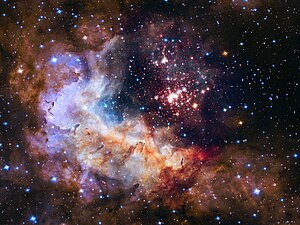WR 20a
|
WR 20a (circled) near Westerlund 2 Credit: NASA, ESA, the Hubble Heritage Team (STScI/AURA), A. Nota (ESA/STScI), and the Westerlund 2 Science Team |
|
| Observation data Epoch J2000 Equinox J2000 |
|
|---|---|
| Constellation | Carina |
| Right ascension | 10h 23m 58.002s |
| Declination | −57° 45′ 48.99″ |
| Apparent magnitude (V) | 13.28 |
| Characteristics | |
| Evolutionary stage | Hot slash star |
| Spectral type | O3If*/WN6 + O3If*/WN6 |
| U−B color index | +0.29 |
| B−V color index | +1.63 |
| Variable type | β Lyr + WR |
| Astrometry | |
| Distance | 20000ly (7900 ± 600 pc) |
| Absolute magnitude (MV) | −6.49 + −6.49 |
| Orbit | |
| Period (P) | 3.675 days |
| Semi-major axis (a) | 26 R☉ |
| Eccentricity (e) | 0 |
|
Semi-amplitude (K1) (primary) |
353.1 km/s |
|
Semi-amplitude (K2) (secondary) |
362.6 km/s |
| Details | |
| Mass | 82.7 ± 5.5 M☉ |
| Radius | 19.3 ± 0.5 R☉ |
| Luminosity | 1,150,000 ± 150,000 L☉ |
| Surface gravity (log g) | 3.8 cgs |
| Temperature | 43000 ± 2000 K |
| Mass | 81.9 ± 5.5 M☉ |
| Radius | 19.3 ± 0.5 R☉ |
| Luminosity | 1,150,000 ± 150,000 L☉ |
| Surface gravity (log g) | 3.8 cgs |
| Temperature | 43000 ± 2000 K |
| Other designations | |
|
V712 Carinae, GEN#+4.38020004, THA 35-II-36, Westerlund 2 MSP 240, 2MASS J10235800-5745489, UBV M 40466, Westerlund 2 4
|
|
| Database references | |
| SIMBAD | data |
WR20a is a binary star associated with the young, massive cluster Westerlund 2. It was discovered in 2004 to be one of the most massive binary systems known, for which the masses of the components have been accurately measured.
Each star in the system has about eighty times the mass of the Sun. It is not clear why this system is located away from the center of the cluster. It is possible that the system was formed in the core, but that it was ejected by dynamical interactions.
Every 3.6 days the two stars in this system revolve around each other. Although the stars are in very tight orbit, both stars in the system are detached.
It is expected that within a million years the two will expand and come into contact. A large nitrogen abundance has been measured on the surface of the stars, about six times the abundance of nitrogen measured in the sun. This nitrogen is probably produced in deeper layers of the star and pushed towards the surface by rotational mixing.
A collision between the two winds of the systems has been detected in the visible as well as in X-rays. The X-ray emitting region is quite extended since it does not suffer from any eclipse.
...
Wikipedia

